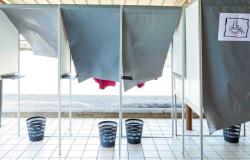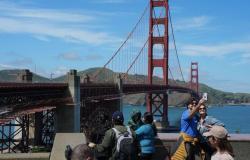(Christ Church) For several years, Colin Rouse has been keeping track of a sad count: that of palm trees falling into the water.
Posted at 5:00 a.m.
“In three years, we lost six. See, this is the last one,” says the manager of the Crystal Waters Beach Bar, pointing to a mound of roots lying on the beach.
We are at Sandy Beach, on the southern tip of the island of Barbados. Sandy Beach means sandy beach. But the place lives up to its name less and less well.
PHOTO PHILIPPE MERCURE, THE PRESS
The remains of a palm tree victim of the effects of climate change at Sandy Beach
There is almost no sand left here. Watching the exposed roots of palm trees cling to sea-worn soil, one wonders whether it is the beach holding back the trees or the palm trees holding back the beach.
“In the 1990s, the beach went all the way to the boats there,” says Mr. Rouse, pointing to the boats which float a good ten meters in the turquoise waters. There was beach volleyball here, competitions. »
I order him a marlin steak with fries and salad with creamy sauce to continue the discussion. On the terrace, the speakers play reggae.

PHOTO PHILIPPE MERCURE, THE PRESS
Colin Rouse, manager of Crystal Waters Beach Bar in Sandy Beach
Colin Rouse was born here in the parish of Christ Church. Today he is worried. Offshore, the coral reef that was a delight for tourists is dead. The waves bring more and more sargassum, these algae which take advantage of the warming of the oceans to proliferate. Once on the beach, they decompose, giving off a pestilential odor.
“We can get them up here, all around,” said Mr. Rouse, placing his hand on his waist.

PHOTO PHILIPPE MERCURE, THE PRESS
Rocks protect the banks and a pedestrian promenade on the west coast of Barbados.
Not to mention that the gradual disappearance of the beach is directly reflected in his cash drawer.
“The smaller the beach becomes, the fewer beach chairs we can put. And the fewer chairs there are, the fewer customers there are for me,” he explains.

PHOTO PHILIPPE MERCURE, THE PRESS
The campus of the University of the West Indies (West Indies)
Rum, sargassum and biofuel
In Barbados, climate change is not just another topic you read about in the newspapers. They are experienced on a daily basis.
However, forget fatalism. Under the leadership of a particularly combative Prime Minister, Mia Mottley, the small Caribbean country has become the voice of nations threatened by climate change.
This leadership rubs off across the country. Whether it is reforming global climate finance or finding very concrete solutions to daily problems, the small country of 280,000 inhabitants is teeming with initiatives.
Take the sargassum that causes headaches for Colin Rouse at Sandy Beach. At the University of the West Indies, researcher Legena Henry is working to transform this nuisance into biofuel.

PHOTO PHILIPPE MERCURE, THE PRESS
Researcher Legena Henry is co-director of the company Rhum and Sargassum, which wants to transform sargassum into biofuel.
The idea is to kill two birds with one stone: solve a problem that harms tourism and help the country achieve its (very ambitious) goal of freeing itself from fossil fuels by 2030.
To make biofuel from sargassum, you need water. However, Barbados is seriously lacking it. The M solutionme Henry: recover the water rejected by the country’s emblematic rum distilleries.
“Rum is Barbados and Barbados is rum,” says the 43-year-old woman, explaining that these residual waters from distilleries prove particularly conducive to her process.
At the time of our meeting, the company she created from her university lab, Rhum and Sargassum, was preparing a big launch where she will run a vehicle with her biofuel in front of members of the government.

PHOTO PHILIPPE MERCURE, THE PRESS
The Rhum and Sargassum company monitors the masses of sargassum live in order to predict which ones will reach the coasts. These masses can then be collected and transformed into biofuel before they reach the banks.
M’s journeyme Henry shows the power of Barbados to attract climate innovators. Originally from the neighboring island of Trinidad, Mme Henry went into exile in the United States to do a master’s degree in engineering at the prestigious MIT, near Boston.
“Like many members of our team, I wanted to return to the Caribbean to contribute to solutions,” she says. It was in Barbados that she found the impetus around renewable energies necessary to launch her project.
This is exactly what the local government was aiming for when it launched BLOOM, the Caribbean’s first cleantech industrial cluster, in collaboration with the United Nations Industrial Development Organization.

PHOTO PHILIPPE MERCURE, THE PRESS
In Barbados, an ambitious program called HOPE aims to build 10,000 energy-efficient, hurricane-resistant homes for low-income residents.
From roofs to reefs
If Barbados’ fight against climate change has a general, it is Ricardo Marshall. Reporting directly to Prime Minister Mottley’s office, Mr Marshall is director of the Roofs to Reefs program – the country’s plan to combat climate change.
From the coast to the countryside to the capital, I followed Mr. Marshall for a day in the field to see the efforts being made. A sign that the country is attracting international attention, a Swiss journalist and a Barbadian journalist who was collecting information for an American media outlet were also present.
With his sunglasses and his beach hat, Ricardo Marshall displays the debonair air of a vacationer. But when he speaks, we discover an energetic man who does not speak wooden language.
“Donors and international funders often encourage us to deploy solutions based on nature and ecosystem adaptation. It’s local, cheap, small scale. They can put their people on development magazines and it looks good,” he tells us from the outset.

PHOTO PHILIPPE MERCURE, THE PRESS
Ricardo Marshall, Roofs to Reefs Program Director
But we want to have an impact for the people of this country. And when you want to protect people and property, sometimes you need heavy infrastructure.
Ricardo Marshall, Roofs to Reefs Program Director
The tone is set.
Once on the coast, we understand what he means.
“You are standing here on a coastal protection structure,” says Karima Degia, deputy director at the Prime Minister’s office, who accompanies us during the visit. Beneath our feet are rocks on which the waves break. Their role is to protect the banks from rising water and storms.

PHOTO PHILIPPE MERCURE, THE PRESS
Karima Degia, deputy director in the office of Barbados Prime Minister Mia Mottley, stands on a protective barrier erected to protect the riverbanks from the effects of climate change.
All these stones were imported. “Those on the island are made of fossilized coral and would have been too light to provide real protection,” explains Ricardo Marshall.
This rock wall supports a pedestrian promenade that stretches for half a kilometer. It is interrupted here and there to give way to the fine sandy beaches for which the island is famous. Obviously, some beaches have disappeared because of the work.

PHOTO PHILIPPE MERCURE, THE PRESS
Karima Degia, deputy director in the office of Barbados Prime Minister Mia Mottley, explains the country’s efforts to adapt to climate change.
It generated all kinds of opinions. As you can imagine, Barbadians have a strong sense of ownership towards their riverfronts and beaches. But you can’t please everyone and you have to do what is in the public interest.
Karima Degia, deputy director in the office of the Prime Minister of Barbados, Mia Mottley
Contrary to what one might think, the threat here does not only come from the sea. Ricardo Marshall shows us the landscape which rises as we move away from the coast. The topography of the island means that the west coast, particularly developed, is located at the mouth of a type of natural basin. When tropical storms hit – and they hit more and more often and harder and harder – rainwater rushes down the slopes and converges here, where it floods everything.
To counter the phenomenon, Roofs to Reefs built an entire system of pipes intended to evacuate excess water to the ocean. Large grassy ditches were also created to accommodate excess water.
Protecting infrastructure is one thing, but the Barbados government also wants to protect its citizens. An ambitious program called HOPE aims to build 10,000 energy-efficient, hurricane-resistant homes for low-income residents.

PHOTO PHILIPPE MERCURE, THE PRESS
One of 10,000 energy-efficient, hurricane-resistant homes built under the HOPE program
Criticized for its delays and cost overruns, the program has so far shown modest results. In Lancaster, a few kilometers from the coast, I was able to visit a brand new neighborhood made up of 154 of these white two or three bedroom houses which are starting to welcome their first inhabitants.
Black-bellied sheep, an emblematic species of Barbados, come to graze there and are currently more numerous than humans. The project is partly financed by the Blue Green Bank, a new bank entirely dedicated to financing initiatives to combat and adapt to climate change and to which several international institutions contribute.
At Sandy Beach, bar manager Colin Rouse rails against the government for doing nothing to protect his beach. But it is clear that elsewhere, the small country is fighting with the energy of despair. Hoping to convey his sense of urgency to the rest of the world.

















